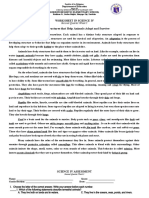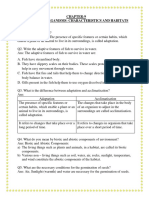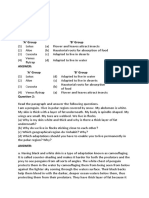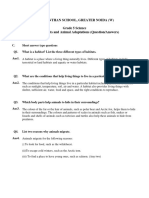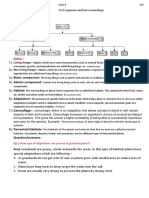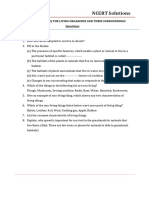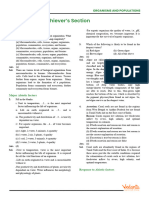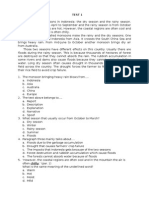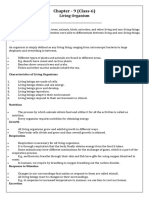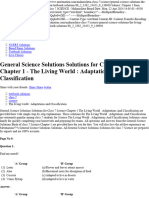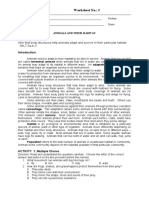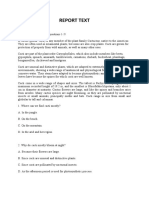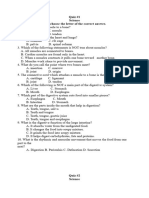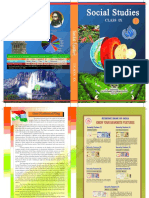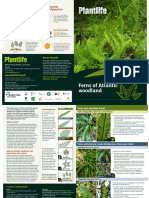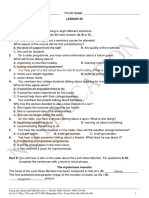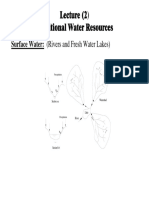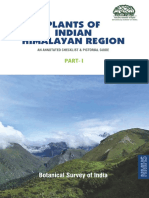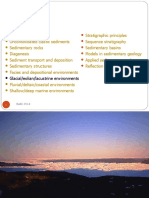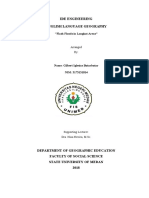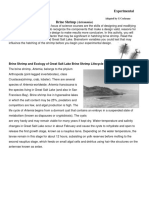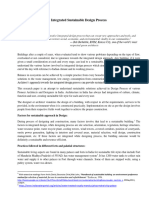The Living Organisms Characteristics and Habitats Edited
The Living Organisms Characteristics and Habitats Edited
Uploaded by
syogeshkumar1983Copyright:
Available Formats
The Living Organisms Characteristics and Habitats Edited
The Living Organisms Characteristics and Habitats Edited
Uploaded by
syogeshkumar1983Original Title
Copyright
Available Formats
Share this document
Did you find this document useful?
Is this content inappropriate?
Copyright:
Available Formats
The Living Organisms Characteristics and Habitats Edited
The Living Organisms Characteristics and Habitats Edited
Uploaded by
syogeshkumar1983Copyright:
Available Formats
INTERNATIONALINDIANSCHOOL,ALJUBAIL(KSA)
SUBJECT: SCIENCE CLASS:VI June 2024
The living organisms’ characteristics and habitats
Define:
1. Adaptation: The presence of specific features and habits, which enable an organism
to live naturally in a place is called adaptation.
2. Biotic component: These are the living components of the ecosystem.
Ex: all plants. Animal and microorganisms
3. Abiotic components: The These are the non-living components of the ecosystem.
Ex: soil, water, air, sunlight
4. Habitat:The
:The place where organisms live is called habitat.
5. .Respiration:: The chemical process of breakdown of food with the release of energy
is called respiration
I. Answer the following questions:
1. How is camel adapted to survive in a desert?
Camels have long legs which hel help to keep their bodies away from the heat of
the sand. They excrete small amount of urine .Their dung is dry and they do not
sweat. Since camels lose very little water from their bodies they can live for many
days without water.
2. How is cactus adapted to survive in a desert?
Cactus is adapted to survive in a desert as it has
(i) No leaves or spiny leaves to prevent water loss through transpiration.
(ii) Stem is modified in such a way that it performs photosynthesis and
conserves water.
(iii) Their roots stay close to the soil surface to better absorb rainfall, and
gather more nutrients.
3. How are rats and snakes adapted to live in the desert? Make a diagram to
show their living space.
Ans.: Some animals like rats and snakes do not have long legs like camels to stay
away from the effect of heat during the day. They stay in burrows deep in the
sand. They come out only during the night.
4. Explain the adaptation of trees to live in mountain regions.. Draw a diagram to
show the shape of trees.
(i) The shape of the trees is of normally cone type.
(ii) Branches are sloping.
(iii) The leaves of these trees are needle like.
(iv)These
hese structures prevent accumulation of rainwater and snow over them.
5. Explain the adaptation of animals to live in mountain region.
(i) The animals have thick skin or fur to protect them from the cold.
(ii) Some animals have thick fu
furr on their body, feet and toes which protect them from
cold on walking in the snow.
(iii) The goats have strong hooves for running up on rocky slopes.
6. Explain the adaptation of plants to live in water.
Ans.:
(i) Roots are reduced in size which holds the plant.
(ii) Stems are long, hollow and light.
(iii) Stems grow up to the surface of water.
(iv) Leaves and flowers float on the surface of water.
(v) The leaves are covered by a waxy layer which protects the leaves from
excessive water.
7. List the common characteristics of living things.
Some common characteristics of living things are:
They require food to grow and carry out life processes
They grow in size
All living organisms breathe and respire (the process of generating energy)
They Respond to stimuli (changes in the environment)
They carry out reproduction (producing the next generation) and
excretion(elimination of waste from the body)
Movement is shown by living organisms
Give Reason
Q. Dolphins and whales come on the surface of water frequently.
A. Dolphins and whales do not have gills. They breathe in air through nostrils
or blow holes that are located on the upper parts of their heads. This allows
them to breathe in air when they swim near the surface of water .So they come
out to the surface from time to time ,to breathe in air.
Reason and Assertion Questions:
This consists of two statements – Assertion (A) and Reason (R), Answer the
questions by selecting the appropriate option given below:
(a) Both A and R are true, and R is the correct explanation of A.
(b) Both A and R are true, and R is not the correct explanation of A.
(c) A is True but R is false.
(d) A is False but R is true.
Q1. Assertion: Any animal that adapts itself against heat and water scarcity is well
suited for desert conditions:
Reason(R): In deserts, only little water is available
Ans.: option A
Q2. A: Some abiotic factors like air, water, light and heat are very important for the
growth of plants.
R: The abiotic factor, soil is a home to many animals like rats and snakes
Ans.: option B
CASE STUDY QUESTIONS:
Q1. A lion is a strong animal which has eyes in the front side of the face. It has long claws that can
be withdrawn inside the toes. It is of light brown color.
A deer has strong teeth and long ears. It has eyes on the side of its head. It is an animal which can
run at a great speed.
In which habitat do you expect a lion and a deer to be found together?
Ans.: Grassland
Why does a lion have eyes in the front side of its face?
Ans.: The eyes of the lion allow it to have a correct idea about the location of its prey.
Why does a deer have long ears?
Ans.: Its long ears help it to hear the sound of the movement of its predators.
What are the terms that can be used for the lion and the deer in the above case study?
Ans.: The lion is the predator while the deer is the prey.
You might also like
- Pima County Comments To Arizona DEQ About Copper WorldDocument20 pagesPima County Comments To Arizona DEQ About Copper WorldKOLD News 13No ratings yet
- Body Structures That Help Animals Adapt and Survive: Worksheet in Science IvDocument2 pagesBody Structures That Help Animals Adapt and Survive: Worksheet in Science IvAnnabelle Poniente HertezNo ratings yet
- Science 4 2ndPE 2016Document3 pagesScience 4 2ndPE 2016Alea100% (1)
- Living Organisms Characteristics and Habitats Related Questions (CH 9)Document20 pagesLiving Organisms Characteristics and Habitats Related Questions (CH 9)Srijan MauryaNo ratings yet
- The Living Organisms and Its Habitats Extra QuestionsDocument4 pagesThe Living Organisms and Its Habitats Extra QuestionsSanjivram S 10bNo ratings yet
- 4 Habitat of Living 20 Feb 24Document8 pages4 Habitat of Living 20 Feb 24ramasenNo ratings yet
- Grade 6 Chapter 9 Q & ADocument5 pagesGrade 6 Chapter 9 Q & ARoshnahema NNo ratings yet
- Living Organisms - Characteristics and HabitatsDocument3 pagesLiving Organisms - Characteristics and HabitatskashviNo ratings yet
- Chapter-9 The Living Organisms-Characteristics and Habitats Question Bank - 1Document6 pagesChapter-9 The Living Organisms-Characteristics and Habitats Question Bank - 1Roshni VishwakarmaNo ratings yet
- Living Organism CHP 10Document4 pagesLiving Organism CHP 10Vijaydahiya0007No ratings yet
- VI-9-The Living Organisms and Their SurroundingsDocument19 pagesVI-9-The Living Organisms and Their SurroundingsMusfarNo ratings yet
- Chapter No 1: The Living World: Adaptions and ClassificationDocument9 pagesChapter No 1: The Living World: Adaptions and Classificationaakankshabhopatrao36No ratings yet
- Chapter 9Document7 pagesChapter 9saakittuNo ratings yet
- C06 - Science - 11. Habitats of OrganismsDocument4 pagesC06 - Science - 11. Habitats of OrganismsLokesh AgarwallaNo ratings yet
- 6 S Living Things NotesDocument5 pages6 S Living Things NotesVIKASYOJANAEduCareNo ratings yet
- 6. – The Living Organisms Characteristics (1)Document2 pages6. – The Living Organisms Characteristics (1)Suchita MantriNo ratings yet
- Q Ans The Living Organisms Characteristics and HabitatDocument5 pagesQ Ans The Living Organisms Characteristics and HabitatSweetandSour CandyNo ratings yet
- Class 6 Sci CH - 6 Living Organism NotesDocument2 pagesClass 6 Sci CH - 6 Living Organism Notesjenilbavishi79100% (1)
- AdaptationDocument5 pagesAdaptationBipasha VakhariaNo ratings yet
- Ch2 Animal Adaptations Q and ADocument4 pagesCh2 Animal Adaptations Q and AankurmalhNo ratings yet
- Adaptationa and ClassificationsDocument8 pagesAdaptationa and ClassificationsJating JamkhandiNo ratings yet
- The Living Word - Adaptation and Classification: Om mane-VIIDocument69 pagesThe Living Word - Adaptation and Classification: Om mane-VIIDhanaji WakadeNo ratings yet
- Ch-9 (Organismas & Their Surroundings) - MergedDocument7 pagesCh-9 (Organismas & Their Surroundings) - MergedZaid KhanNo ratings yet
- A Letter To The GodDocument2 pagesA Letter To The Godmsdhoni122333444455555No ratings yet
- Living Organisms NotesDocument3 pagesLiving Organisms NotescharliecharliestoryNo ratings yet
- Bio CH 5Document4 pagesBio CH 5diablodeathlockNo ratings yet
- STD 7 chp1 NotesDocument2 pagesSTD 7 chp1 Notesrahulbd4uNo ratings yet
- The Living Organisms and Their SurroundingsDocument2 pagesThe Living Organisms and Their SurroundingsAnanya RaiNo ratings yet
- Chapter 8 / Part DDocument4 pagesChapter 8 / Part DKunalKaushikNo ratings yet
- NCERT Solutions For Class 6 Science Chapter 9 The Living Organisms and Their SurroundingsDocument4 pagesNCERT Solutions For Class 6 Science Chapter 9 The Living Organisms and Their SurroundingsHarshNo ratings yet
- The Living OrganismsDocument16 pagesThe Living Organismsmr1977No ratings yet
- Gr. 6 Ch.6 Extra QuestionDocument10 pagesGr. 6 Ch.6 Extra QuestionManit ShahNo ratings yet
- Adaptations Class6 Sci NDocument2 pagesAdaptations Class6 Sci NravilullaNo ratings yet
- Ncert Solutions Class 6 Science Chapter 9Document3 pagesNcert Solutions Class 6 Science Chapter 9aksrm128482No ratings yet
- Bio STD 6 Habitat and Adaptation - Part 1Document2 pagesBio STD 6 Habitat and Adaptation - Part 1nandaniag0311No ratings yet
- Ex-3 Organisms and Population Question and SolutionDocument9 pagesEx-3 Organisms and Population Question and Solutiondidyouknew24No ratings yet
- JSS2 Basic Science 1st TermDocument35 pagesJSS2 Basic Science 1st TermAliyu Lawal KofaNo ratings yet
- There Are Two Seasons in IndonesiaDocument5 pagesThere Are Two Seasons in IndonesiaMutia ChimoetNo ratings yet
- Class 6 Sci CH - 6 Living Organism WS-1 ApDocument2 pagesClass 6 Sci CH - 6 Living Organism WS-1 Apjenilbavishi79No ratings yet
- Chapter 9Document6 pagesChapter 9Abhinaba PaulNo ratings yet
- Chapter 1 From Textbook General Science Solutions For Class 7 SCIENCE - Maharashtra BoardDocument7 pagesChapter 1 From Textbook General Science Solutions For Class 7 SCIENCE - Maharashtra BoardmaheshshanyaparabNo ratings yet
- Learn and Write The Following Question AnswersDocument3 pagesLearn and Write The Following Question AnswersDipti BhagatNo ratings yet
- Report TextDocument7 pagesReport TextsmpNo ratings yet
- Science 4 Worksheet No.: 2Document3 pagesScience 4 Worksheet No.: 2arellano lawschool100% (4)
- GR - 4 - Science Revision WorksheetDocument4 pagesGR - 4 - Science Revision WorksheetRaihana ReemNo ratings yet
- Report Text SoalDocument10 pagesReport Text SoalRifqi ZakwanNo ratings yet
- Science Report (Kris & Bry)Document60 pagesScience Report (Kris & Bry)Bryan Mallen IsnaniNo ratings yet
- Quizzes 1-4Document4 pagesQuizzes 1-4Nikki Mae NarizNo ratings yet
- F6 English IeltsDocument42 pagesF6 English IeltsFendy Eko HariyantoNo ratings yet
- Revision 1 Term 2 2022 AKDocument7 pagesRevision 1 Term 2 2022 AKMohamed ElsisyNo ratings yet
- 2ND Periodical Test in Science 4Document4 pages2ND Periodical Test in Science 4Mary An TorresNo ratings yet
- 5th Class Science NotesDocument4 pages5th Class Science Notesmalikgraphics0No ratings yet
- Science Chapter 6Document13 pagesScience Chapter 6GM EstradaNo ratings yet
- Term 2 Class 6 WS 2Document2 pagesTerm 2 Class 6 WS 2ksrini1981No ratings yet
- Teks Report Chika K.K & Karunia P.ADocument4 pagesTeks Report Chika K.K & Karunia P.AAisyah DiniNo ratings yet
- Grade 6 Test 1. Integrated ScienceDocument2 pagesGrade 6 Test 1. Integrated SciencetonychipuliloNo ratings yet
- Saransh 1Document23 pagesSaransh 1Raj DwivediNo ratings yet
- Science 4 Q2Document8 pagesScience 4 Q2Gemma Gina CabahugNo ratings yet
- Class 6 - Chapter 9 - The Living Organisms and Their SurroundingsDocument3 pagesClass 6 - Chapter 9 - The Living Organisms and Their SurroundingskishanrwtNo ratings yet
- Class 7 The DESERT Extra QuestionDocument5 pagesClass 7 The DESERT Extra QuestionpawankavarNo ratings yet
- O Level Biology Practice Questions And Answers: Ecology And Our Impact On The EcosystemFrom EverandO Level Biology Practice Questions And Answers: Ecology And Our Impact On The EcosystemNo ratings yet
- Learn How To Inspect Rest RoomDocument8 pagesLearn How To Inspect Rest RoomRameshNo ratings yet
- IX Social StudiesDocument294 pagesIX Social StudiesKarthik Srinivas NarapalleNo ratings yet
- Construction Stage Guidelines - iHUBDocument54 pagesConstruction Stage Guidelines - iHUBRutul TalsaniaNo ratings yet
- Sanitary Permit: Office of The Building OfficialDocument2 pagesSanitary Permit: Office of The Building Officialhje421No ratings yet
- Ferns of Atlantic Woodland: Some Key Terms and Features To Look For When Identifying FernsDocument4 pagesFerns of Atlantic Woodland: Some Key Terms and Features To Look For When Identifying FernsFebrian IanNo ratings yet
- PDS Total Guard 16B16 ENDocument2 pagesPDS Total Guard 16B16 ENhai phanNo ratings yet
- Kobelco Eco-Solutions VNDocument20 pagesKobelco Eco-Solutions VNPhu PhuocNo ratings yet
- Wildlife Conservation and Mangrove Interpretation Centre, Karamjal, SundarbanDocument16 pagesWildlife Conservation and Mangrove Interpretation Centre, Karamjal, SundarbanShif renNo ratings yet
- Particular Specification M15: Filter Belt Press Equipment: Johannesburg Water SOC LTDDocument11 pagesParticular Specification M15: Filter Belt Press Equipment: Johannesburg Water SOC LTDHadise NikdelNo ratings yet
- 7A L30 Phiếu BTDocument7 pages7A L30 Phiếu BTAn Tran MinhNo ratings yet
- Algebra 2 ProjectDocument8 pagesAlgebra 2 ProjectHanan anzawiNo ratings yet
- Lecture (2) Traditional Water Resources: Surface Water: (Rivers and Fresh Water Lakes)Document9 pagesLecture (2) Traditional Water Resources: Surface Water: (Rivers and Fresh Water Lakes)mohamed ahmedNo ratings yet
- CR 2 Isometric Plan: Plumbing SymbolsDocument1 pageCR 2 Isometric Plan: Plumbing SymbolsAlyanna Marie PalenciaNo ratings yet
- Geography p2 Memo Gr11 Nov2022 - EnglishDocument9 pagesGeography p2 Memo Gr11 Nov2022 - Englishthandothemane253No ratings yet
- Perhitungan Volume Dan Dimensi Kolam Limbah Pt. Sjal Silaut RevDocument1 pagePerhitungan Volume Dan Dimensi Kolam Limbah Pt. Sjal Silaut RevUsman SAleh AfifNo ratings yet
- BSI - Plants of Indian Himalayan Region Part - I - 2019Document650 pagesBSI - Plants of Indian Himalayan Region Part - I - 2019saleemNo ratings yet
- Arc Hydro For StormwaterDocument24 pagesArc Hydro For Stormwaterمهندس ابينNo ratings yet
- Site Development PlanDocument1 pageSite Development PlanDave KhylNo ratings yet
- GEOTECHNICAL ENGINEERING PlatesDocument2 pagesGEOTECHNICAL ENGINEERING PlatesJoshua GarnaceNo ratings yet
- Pico Hydro ThesisDocument6 pagesPico Hydro Thesispwqlnolkd100% (2)
- 08 Glacial Eolian Lacustrine EnvironmentDocument46 pages08 Glacial Eolian Lacustrine EnvironmentMas KulinNo ratings yet
- Third Periodical Test 2022 2023Document5 pagesThird Periodical Test 2022 2023Renelyn Mendez BergunioNo ratings yet
- Advance Safety SeminarDocument34 pagesAdvance Safety Seminarpp3986No ratings yet
- Rekayasa Ide B. InggrisDocument7 pagesRekayasa Ide B. InggrisAnonymous I6o2RoXpnNo ratings yet
- Schedule of Rates '2014 - Water Supply WorksDocument49 pagesSchedule of Rates '2014 - Water Supply WorksanshdivyNo ratings yet
- Vertical DrainsDocument85 pagesVertical DrainsDương NguyễnNo ratings yet
- Brine Shrimp LabDocument7 pagesBrine Shrimp LabaaronhwparkNo ratings yet
- Integrated Sustainable Design Process - Aurora PaperDocument5 pagesIntegrated Sustainable Design Process - Aurora PaperPadmashri Kadarla MaharajNo ratings yet
- Video Recap of Osmosis by Amoeba Sisters Answer SetDocument2 pagesVideo Recap of Osmosis by Amoeba Sisters Answer SetDin Din100% (2)

